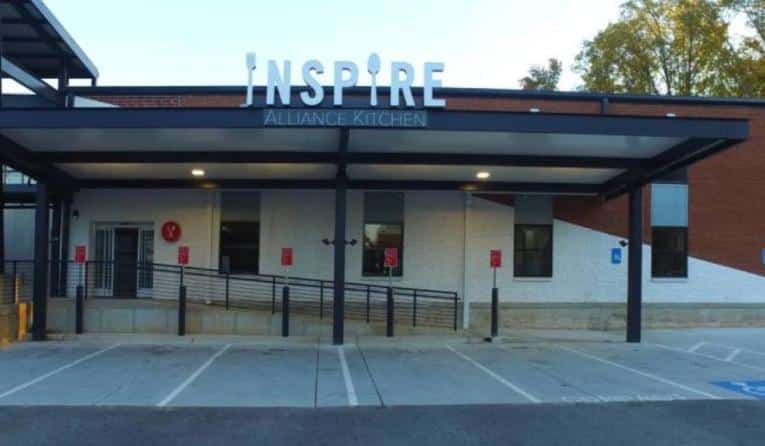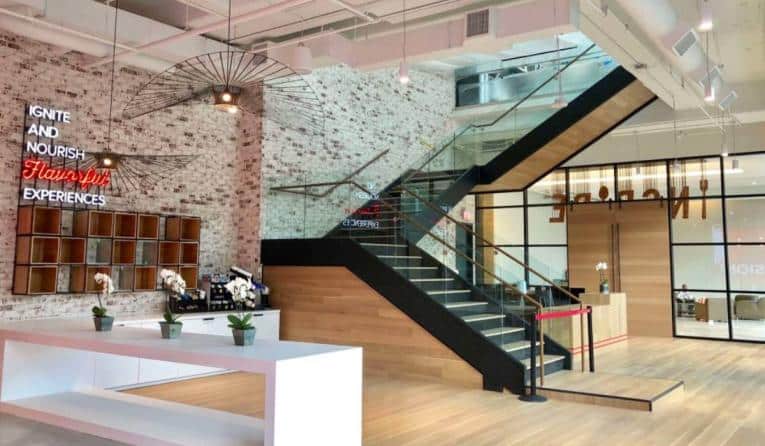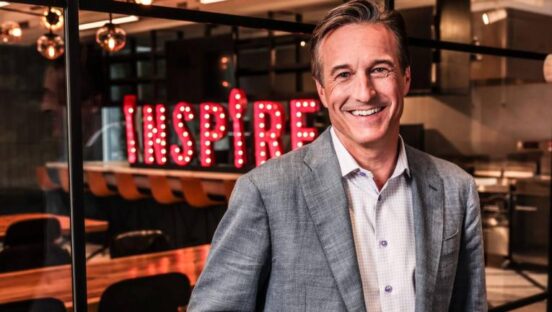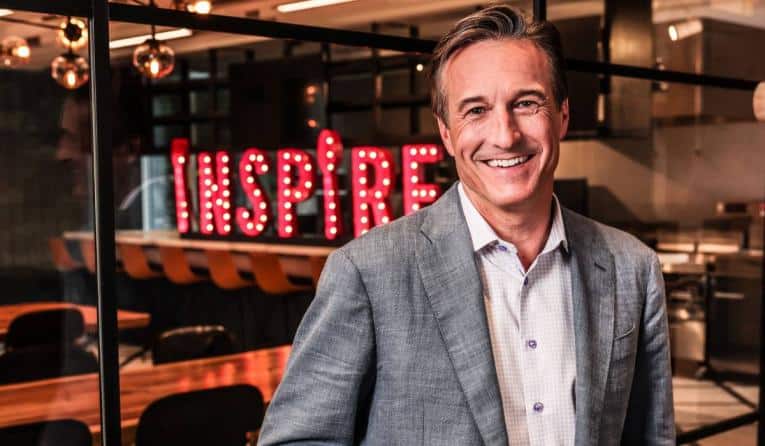Christian Charnaux worked with Paul Brown when the two were executives at Hilton. So the phone wasn’t exactly cold when it rang. But the notion of restaurants? That was a thought that needed to thaw. Beyond being a convincing guy, Brown pitched a vision with a hook Charnaux couldn’t resist—there was no playbook.
Five years later, Charnaux, Inspire Brands’ chief growth officer, sits in a glass-walled office overlooking what’s colloquially called “400” by locals. It’s a view of US-19/GA-400 that sits above Atlanta traffic and, on clear days, you can see mountains in the backdrop. Charnaux’s shelves are stacked with paraphernalia, including a Jimmy John’s sign unsuited for a PG audience.
When asked if he could foresee this manifestation—a 1,000-person HQ in Sandy Springs, Georgia—with floors decked for every brand, beer taps and ice cream in the common room, and a 15,000-square-foot Innovation Center, Charnaux offers one word: “No.”
To understand the logic that sprouted Inspire’s empire, it’s worth tracing back the timeline. In February 2018, Arby’s Restaurant Group closed a $2.9 billion deal for Buffalo Wild Wings—a blockbuster that gave rise to the company’s new name. Yet Inspire was already stirring behind the curtain. The headline: “Arby’s Buys Buffalo Wild Wings,” welcomed a wave of social media noise, much of it muddled. Can I order roast beef with wings now? “That doesn’t make any sense,” Charnaux says. “But no, this was a family approach and a family of brands that we were putting together. That’s why Sonic was such an important acquisition for us.”
The Sonic Drive-In deal ($2.3 billion) arrived in December 2019. Come October, Inspire added Jimmy John’s for an undisclosed amount, transferring the business from one entity of Inspire-backer Roark Capital to another (Roark bought a majority stake in 2016). Then, Inspire struck its headliner roughly a year later when it locked up an $11.3 billion move for Dunkin’ and Baskin-Robbins. It marked the highest-dollar restaurant acquisition since 3G Capital LP, Burger King Worldwide Inc., acquired Tim Hortons for $12.64 billion in August 2014.
And it simply carried Inspire to rare air. The company, at a recent count, totaled roughly 31,700 restaurants and $30 billion in system sales, making it the second largest restaurant conglomerate in the U.S. behind Taco Bell, KFC, Pizza Hut, and Habit Burger owner Yum! Brands. Aaron Allen, CEO and chief global strategist of his eponymous Aaron Allen & Associates, once called Inspire, “the fastest-growing foodservice company in the history of the world.”
It’s a difficult point to argue.
And so, this brings us back to Charnaux’s chat with Brown, the prior president of brands and commercial services of Hilton Worldwide (Charnaux’s was most recently SVP of corporate finance at the hotelier). Surveying the restaurant field, Charnaux observed a $600 billion business that, unlike the hotel space, was “crazy fragmented.” In hospitality, following Marriott International’s 2015 deal to buy Starwood Hotels & Resorts Worldwide, giving it 30 brands and more than a million rooms under operation, the sphere had “maybe six” real players globally. “You have, just in the U.S. alone, 20 [restaurant] players you could name that were at national scale. If you look at the opportunity of everything that we learned in the hospitality business, that whole disruption that happened 10, 15 years ago of digitalization; basically keeping up with what customers want and how they interact with you, plus, OTAs and the third-party delivery rise, there’s a comparative there,” Charnaux says. “Clearly, multi-brand makes sense like it does in hospitality.”

“The real story of Inspire,” says Christian Charnaux, the company’s chief growth officer, “is you’re getting all of these pieces together and really taking the time outside of the rude gaze of public scrutiny and being a public company, and tightly integrating them in a way that’s very hard for anyone else to do and hasn’t been done before.”
Inspire also had Roark Capital. Brown and Neal Aronson, founder and managing partner of the fund, partnered to form the framework you see today, which is designed to acquire major concepts and develop a shared-services structure that enables each brand to pull from a center of strength for the collective good. That, in a certain manner, is not unlike hotels.
But the starting point, before there even was one, was scale. “You can’t do all the fun stuff unless you have the shared scale,” Charnaux says.
Pre-COVID, restaurants faced digital disruption from more corners than a city square. Hospitality knew the feeling all too well (booking sites come to mind), and Charnaux and Brown navigated it firsthand. While a global pandemic wasn’t on the whiteboard, Brown understood change was coming. Wherever the world went, companies with scale and brands that served different needs, times, and occasions, would be positioned to win. Or, as Charnaux explains it, you’d have a leg up by becoming an organization with “tightly integrated scale.”
“Where you’re touching a lot of different customers and brands and you’re able to leverage that shared knowledge across brands,” he says. “If you can do that, you’re going to be more relevant to the customer, you’re going to be where the customers wants, in the right channel, at the right time, with the right message, and leverage those insights across all those brands.”
INSPIRE’S LINEUP (all figures year-end 2022, U.S.)
Arby’s
- Systemwide sales (in millions): $4,535
- AUV (in thousands): $1,300
- Franchised units: 2,305
- Company units: 1,110
- Total units: 3,415
- Change in units from 2021: 6
Dunkin’
- Systemwide sales (in millions): $11,279
- AUV (in thousands): $1,200
- Franchised units: 9,339
- Company units: 31
- Total units: 9,370
- Change in units from 2021: 126
Sonic Drive-In
- Systemwide sales (in millions): $5,499
- AUV (in thousands): $1,600
- Franchised units: 3,221
- Company units: 325
- Total units: 3,546
- Change in units from 2021: –6
Jimmy John’s
- Systemwide sales (in millions): $2,364
- AUV (in thousands): $900
- Franchised units: 2,597
- Company units: 40
- Total units: 2,637
- Change in units from 2021: –26
Baskin-Robbins
- Systemwide sales (in millions): $685
- AUV (in thousands): $300
- Franchised units: 2,253
- Company units: 0
- Total units: 2,253
- Change in units from 2021: –54
Buffalo Wild Wings
- Systemwide sales (in millions): $3,937
- AUV (in thousands): $3,300
- Franchised units: 708
- Company units: 534
- Total units: 1,242
- Change in units from 2021: 18
The diner isn’t likely to understand Sonic and Jimmy John’s share the same parent group. That was never the intention of Inspire. Customers aren’t taking three left turns to go to Arby’s so they can use reward points at Buffalo Wild Wings like they might with Hampton, Hilton, and DoubleTree.
At Inspire, you’ll see (without noticing) an app that may have the same shared infrastructure as Buffalo Wild Wings and Arby’s but is more relevant to users since it crosses occasions. That’s how Inspire drives incrementality.
Scale and consolidation, generally, isn’t a new concept to restaurants. But Inspire’s approach veered in key areas. For one, it’s a 93 percent franchised business. Most companies at this size don’t have nearly as much skin in the corporate game. So, much of Inspire’s innovation is a test-and-learn model that directly impacts the company’s P&L and affects how it approaches change.
Take Buffalo Wild Wings as a case. At the onset of COVID, the 1,200-unit-plus sports bar had online ordering and an app for loyalty. However, 79 percent of business occurred within the four walls.
The shared tech support of Inspire allowed it to scale the chain’s digital platform and get back in front of guests. And then came a leap to becoming a tech-enabled concept through what Inspire dubbed, the “choice model.” Buffalo Wild Wings customers now have the option to scan an integrated QR code at the table and decide how they want to engage with employees. They can order, add to their order, and pay on their own. Or, they can take a hybrid approach with some team member interaction. Conversely, if they want a full-service restaurant experience, it’s available, too.

When Inspire approached franchisees about the fundamental shift, which boils down to a model with more runners than servers, it did so through a lens of personal investment. “I don’t think Buffalo Wild Wings would be doing that if they were still an independent company,” Charnaux says. “It would be a lot harder for them to do that versus leveraging infrastructure that we have and are already using at different brands.”
It would also ultimately lead to Inspire’s counter-service “BWW Go.” The initial store debuted 2020 in Atlanta at 1,800 square feet, with a walk-up counter, digital menu boards, and a small seating area with TVs to entertain customers while they wait for their order. Order-ahead guests pick up via heated lockers.
The typical size ranges from 1,100 to 1,600 square feet, with the average thus far being 1,501. At the end of last year, the top third of 35 reporting BWW Gos averaged $25,707 in weekly sales, or about $1.3 million AUV. The full system average was $992,000. In total, there were 41 BWW Gos year-end 2022, up 25 from the prior year.
Inspire did the first 50 itself, Charnaux says. “We wanted to make sure the economics worked, the returns were there. It just allowed us more freedom to tweak,” he says. “And now, we’re opening it up broadly to franchising.”
Charnaux says Inspire believes it will tout “hundreds” of BWW Go outlets in the U.S. in “very short order.” The company found it could fortress markets with both formats, which resulted in additional share, not less.
And again, the wide potential lies in the shared vision. Inspire operates in casual dining, quick service, and all varieties of delivery—captive, third party, even hybrid with Jimmy John’s and DoorDash to fulfill. Digital to in-store, there are learnings to unlock and cross-pollinate.
Additionally, Charnaux says, the fact Inspire is a private entity allows it to make longer-term bets.
“The real story of Inspire,” he says, “is you’re getting all of these pieces together and really taking the time outside of the rude gaze of public scrutiny and being a public company, and tightly integrating them in a way that’s very hard for anyone else to do and hasn’t been done before.”
Inspire produced U.S. digital sales growth over 35 percent in 2021 versus 2020 to $6 billion-plus—good for more than 20 percent of domestic system sales. It also surpassed $1 billion in sales via third-party marketplaces. The loyalty user base hiked to nearly 50 million members.
“Most of it is actually a tech capabilities platform play, right?” Brown says of how Inspire helps acquired chains. “That’s really where the majority of the benefits are. We’re making really good progress on that. We’re not done, obviously. We haven’t even finished building all those platforms. Even if you look at our digital platform. We have two of the brands on a common one: Arby’s and Buffalo Wild Wings. We’ll have Sonic on before the end of the year. But that’s a journey as well.”
Where Inspire moved faster was demand generation. Joint media buys and planning, and analytics, Brown says.
Much of Inspire’s ability to boost performance stems from focus as well. Jimmy John’s never tried LTOs before the sale, or combos. It didn’t attempt a lot of beverage innovation, either. “It’s killing it right now with content,” Brown says. “A lot of it is just because we’re releasing those constraints.”

The No. 1 success metric
Inspire’s blueprint is a visible beacon and one that’s busting at the seams. You can tell just strolling through HQ the company is growing outward in a hurry. But now that Inspire has reached scale unrivaled by all but one restaurant giant, where does it turn the page? For Charnaux, it’s a straightforward spin: Is Inspire attracting outside capital for franchisees to build out restaurants? That organic growth is the proof. “Because they’re getting a better rate of return doing our brands than any of the others—that’s the ultimate metric of success,” he says.
Here is where Charnaux feels Inspire’s differentiation pulses. Even at 31,700-plus locations, he says, Inspire believes each one of its brands has room to double in size. This is a multi-front sketch. Pre-Dunkin’, just 2 percent of Inspire’s stores were outside the U.S. Today, it’s closer to 30 percent. Overall, the company saw a “record number of commitments” in 2022, Charnaux says. “I think we’re going to outpace ourselves for domestic development, again, on commitments,” he adds of 2023.
There’s runway across numerous buckets. Operators are re-upping. New ones are coming in. There’s cross-sell at work—say a Dunkin’ franchisee tapping out a market and deciding to buy a BWW Go or Jimmy John’s. This past year, of Inspire’s commitments, about 30 percent were legacy 1 franchisees signing up for another opportunity.
Charnaux says it’s an industry-wide development. Franchisees are becoming more sophisticated, consolidating and buying brands. One example: SSCP Management, a franchisee of Sonic and Applebee’s, spent $15 million in June to acquire Corner Bakery Café out of bankruptcy.
Operators are striving toward scale and seeking groups that have scale benefits themselves. A decade or so ago, Charnaux says, developers targeted hotel partners who could drive outside returns through a family of brands. Now, the dynamic is coming to restaurants amid a choppy cost market. “So who do you want to work with? Do you want to work with a siloed entity or a single-branded company or do you want to work with a multi-brand company that gives you more options of great brands that you can do in your backyard or beyond,” he says.
And to note, Brown adds, Inspire can go forward entirely from its core.
“We’re already at a scale, I think Dunkin’ put us at a different level than we were pre-Dunkin’,” he says. “I think it’s a good spot to be in. We don’t have to do anything else. If the right thing comes along, it’s a high bar. The worst thing I think a company could do is a bad acquisition. We will not do that. And it’s great because we’re not under any pressure to do that. If you see us doing anything else, it would be a really great brand in a great space that’s complementary in nature to what we already have.”
“From an Inspire Brands standpoint, because of our portfolio of brands and uniqueness of them, and our ability to touch every daypart, it just gives our team a lot of innovation to go after,” says Vans Nelson, Inspire’s SVP of Operations Innovation.
Speaking of Dunkin’, Inspire is just about finished integrating the java behemoth. That was a “huge unlock,” Charnaux says, for everything discussed thus far.
“If you want to get real scale benefits, it’s got to be the same for a franchisee working with Jimmy John’s as it is working with Sonic,” he says.
“… That’s easier said than done. Because five years ago, we were five different companies. And all of sudden, you say, yeah, we’re Inspire. Poof. There’s processes. Systems. All of those things that we’re grinding through. But that’s the great opportunity. If we’re successful, we have something that’s really different than I would say the rest of the industry has. In some ways, more common with what a hospitality company has, if you think about a Marriott and Hilton and how they’re tightly integrated behind the scenes with their commercial engines and their view of the customer.”
Like Jimmy John’s, Inspire let Dunkin’ loose by solidifying its building blocks. Before, Brown says, the brand was often chasing its next LTO, with no real overarching theme or brand idea behind it. “And I think the team has done a great job over the past couple of years of what is the Dunkin’ story we’re trying to tell,” he says. “And how do we focus in on innovation a little bit more around platforms versus sort of the next LTO. And you’re going to see more of that.”
On the international front, the majority of Inspire’s overseas venues today are actually Baskin-Robbins—north of 5,000. Dunkin’ has produced same-store sales over 20 percent for more than 20 months outside the U.S. As a company, Inspire hosted more than 800 new restaurant openings internationally in 2021.
Presently, there are over 600 Dunkin’s in Saudi Arabia. That’s nearly more stores than you’d find west of the Mississippi. Inspire opened its first Saudi Arabia Arby’s in May, which broke sales records. Perhaps even more telling, though, and a signal of what’s to come, it’s a location operated by Shahia Foods Limited Company, a company that runs more than 700 Dunkin’ units across Saudi Arabia, Bahrain, and Germany. On October 1, the same company opened a record 30 Dunkin’ restaurants in one day in Saudi Arabia, an unprecedented number in the brand’s 72-year history.
“There’s a huge opportunity on this cross-sell, but also multi-brand unlocks,” Charnaux says.
What Charnaux means by “multi-brand unlocks” speaks to another realm of whitespace. Real estate has shown little to zero signs of getting cheaper, he notes. So if companies can offer franchisees opportunity to “maximize the throughput of that dirt,” there are gains to be had. Walking into Inspire’s HQ lobby, employees and visitors pass a Dunkin’-Jimmy John’s co-branded outlet that opened in February 2022.
And it’s merely a taste of the company’s non-traditional potential. While Charnaux is not saying there will be 50,000 non-trad outlets for Inspire, he does feel the opportunity is there. The approach should represent 15 percent of what the company does on an annual net unit growth basis, Charnaux adds. Also, Inspire is currently testing a modular, 650-square-foot build that can be used for any of its brands. It’s built off site, fitted to whichever chain is needed, and brought to market.

Charnaux broadly imagines a universe where the company can work with colleges, airports (Jimmy John’s recently launched in Sarasota, Florida’s, airport), and more, on presenting packages of brands that stretch the full daypart gamut. He says Inspire talked with turnpike operators on creating a space that offers something for everyone. And this isn’t just a matter of having multiple concepts. Inspire spent ample time innovating around how to operationalize this kind of approach collectively and in a way that saves space and resources.
Answers it found through another industry-first approach.
Welcome to Alliance Kitchen
In fall 2021, Inspire unveiled “Alliance Kitchen.” You could call it a “ghost” or “dark” kitchen, but, in truth, the label doesn’t do it justice. The space claims the distinction as the first fully developed, owned, and operated multi-brand ghost kitchen in the industry. Or spun differently, nobody has ever melded brands together at this level, for this purpose.
The main split is it’s a one-central-kitchen model that maps product preparation and creation, which allows Inspire to curate different orders for various concepts (in this case, everything but Dunkin’). The segmented kitchen features workspaces that blend to fulfill as opposed to having five separate areas.
There’s also WiFi, charging stations, and free Dunkin’ coffee for couriers.
In many respects, Alliance Kitchen is the digital, virtual manifestation of the co-branded spaces that have long infiltrated quick service. Past offering choice, though, Alliance Kitchen reduced labor requirements by 54 percent, cut square footage needs by 19 percent, decreased equipment costs by 45 percent, and sliced energy consumption north of 50 percent, compared to having five spots.
Vans Nelson, Inspire’s SVP of Operations Innovation, a company vet who’s been with Arby’s and Inspire more than 13 years, credits Alliance Kitchen’s development to many of the company traits Charnaux highlighted. The 2,000 or so corporate units. The shared knowledge. “It’s a unique situation that only we could do,” Nelson says. “We start out at the Innovation Center, we might test some things there, do a proof of concept there. We move it into Alliance Kitchen where it’s a real-world environment, continue to refine, test, and validate, and then deploy to our restaurants into the field and through that process we don’t ask our franchisees to invest until we’re ready and we’re thorough with our testing process.”
When Inspire began conceptualizing Alliance Kitchen, the innovation wheel was ahead of its time. Nelson says it would have been simple to take Arby’s, Buffalo Wild Wings, Sonic, and so forth, and just house them under one roof with independent approaches. It would have tapped into the digital ordering and on-the-go trends of today’s consumer and provided a relief valve for nearby stores. But that would have been one bubble in a lexicon full of them.

Alliance Kitchen was a practice in efficiency, from equipment to utilities to labor, designed to understand how collective, yet different parts could make each one better. Picture a grill where all of the brands’ grill-cooked products are produced in that station. Now, everything flows one direction toward the guest and locker system. Not to mention, cross-trained workers.
And then, couple this concept with what Charnaux portended with non-traditional. “All these non-trad places, these are folks who want plug-and-play kinds of solutions,” he says. “And if you can go to an airport and say, ‘I’ve got coffee, I’ve got sandwich, I’ve got wings, I’ve got Sonic, I’ve got all those things … With Alliance Kitchen, we figured out ways behind the scenes we could man those with shared equipment, shared resources so it’s more productive. That now becomes really, really interesting to operators.” In sum, Alliance Kitchen’s real unlock was learning how to integrate the back of the house across a multi-brand portfolio. Would Inspire have tried that as a pure franchisor? Charnaux doubts it. “We want to do those things because those learnings impact the corporate stores,” he says, “as well as create something for franchisees to get a better return.”
Charnaux is calling this future phase of Inspire’s development “co-location,” versus “co-branding.” Customers aren’t confused and the true drive is efficiency and productivity over breadth of options.
“I love Mexican. I love fried chicken. Do I want to see both together? No, maybe not,” Charnaux says. “But if they have separate dining rooms and areas and are appropriately branded, I think there’s some opportunity there.”
“If you think about the importance of non-traditional locations, because of our learnings in Alliance Kitchen, it enables us to take two brands, three brands, and be able to develop a workflow and a deployment from a kitchen design and layout standpoint that makes everything more efficient,” Nelson adds. “So now you can collaborate from a workforce management standpoint and be much more effective.” Because Inspire was created with diversification central to its DNA, the company is staring down non-trad growth with limitless horizons. It doesn’t need to go brand-by-brand; it can mix-and-match or address a specific need. “Then, if we have an operating model that allows that to be much more efficient, then we can give them that, too,” Nelson notes.
Broadly, Nelson says, the spirit of Alliance Kitchen exists across the company’s directives. Recently, his team spent a good deal of time fine-tuning team member engagement. They focused on details such as restaurant design, workflow innovation, facilities and equipment upgrades, and placement, in an effort to boost performance and satisfaction.
The Innovation Center is where it all takes shape. Nelson says Inspire worked on “operations complexity model innovation,” which set out to define complexity in a “common language that can be spoken throughout the building and throughout the teams.”
Nelson adds these are ambitious times for Inspire, especially when you consider how COVID accelerated many of the trends the company anticipated ahead of it. “From an Inspire Brands standpoint, because of our portfolio of brands and uniqueness of them, and our ability to touch every daypart, it just gives our team a lot of innovation to go after. And so, from an equipment innovation, facilities innovation, process, workflow, innovation, engineering and design, food safety, all of those allows us to be resourced to work across all of our brands to bring solutions to. And that’s what we’re most excited about.”









